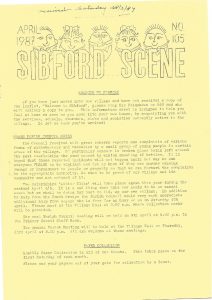The New Extension
In the last two decades of the 19th Century, and until the outbreak of the first World War, the numbers at Sibford Gower Endowed School were in the region of 130. This, when Epwell, Swalcliffe and Tadmarton each had flourishing schools of their own. These numbers, as you can well imagine, caused no little overcrowding.
Joshua Lamb, who though living in the Ferris, was one of the ffoeffees (Trustees) of the Sibford Gower Town Estate Charity, and was one of the Trustee appointments to the governors of the school. He wrote to the Trustees in September 1898 formally asking if the Charity would provide increased accommodation for the infants. The reply, in a letter from the Chairman to the overseers of the Vestry of Sibford Ferris, shewed that charity not only began at home, but firmly stayed there.
“I was instructed as Chairman to call your attention to the following:
- That as ffoeffees of the Sibford Gower Charity estate, we do not consider ourselves managers of Sibford School. That school is, we suppose, considered to be for the school districts of Sibford comprising the two parishes. With Sibford Ferris, we as ffoeffees of the Town Estate Charity have nothing to do, and, upon that Estate Sibford Ferris has no claim.
- We are not aware, that we have at any time accepted any responsibility to provide accommodation in our school, for children from Sibford Ferris. We have only allowed them to avail themselves of such accommodation we can spare for them.
- That the increased accommodation is rendered necessary only for the Ferris children, and the terms of our Trust do not allow us to spend money for their benefit.
- That while we are willing, in consideration of any increased value to our property, arising from any additional building, to share such expenses as may be incurred, we think pressure should be put on the Ferris to provide the necessary acommodation.”
There must have followed a series of letters to the newly formed Board of Educations in Whitehall, we concurred with the opinion of H.M. Inspector that increased accommodation was urgently needed, and, doubtless with the prospect of providing the salary of another teacher for the Ferris, wrote to the overseers of the Sibford Ferris Parish.
—-“I am to enquire, whether the ratepayers or inhabitants of Sibford Ferris are prepared to contribute to this enlargement of the Sibford Gower School as was suggested in the first letter. Failing this it may become necessary for My Lords to issue Notices under statute, with the view of setting up a School Board for Sibford Ferris, which would have to provide a new school at the expense of the rates. It would appear that the better course educationally, and also the cheaper course, would be to enlarge Sibford Gower School —-“
“I am to request that this letter be laid before the inhabitants of Sibford Ferris, at a Parish Meeting, and that you will inform Their Lordships in due course, what course it is proposed to take”.
There is a marginal note here, in pencil by Joshua Lamb, the result was, we saw the necessity of immediate action, and I undertook to endeavour to raise the sum of £300 necessary. This was accomplished arid the addition was built in 1900. I contributed £25 towards the cost myself. Now put that in perspective. £25 was nearly the yearly wage of an agricultural worker. Now about £5,000 and the extension would cost about £60,000 at today’s prices.
The Ferris still had no representative on the School Managers, unless a Charity Trustee from the Ferris was one made available under the Board of Education Trial Order of 1904. Representation was again made in 1921 under the new Education Act, and again in 1945. It wasn’t until recently that Ina Lamb, whose father, as Chairman of the Parish Meeting, had strived for over 25 years for this representation, was appointed as a School Governor.
